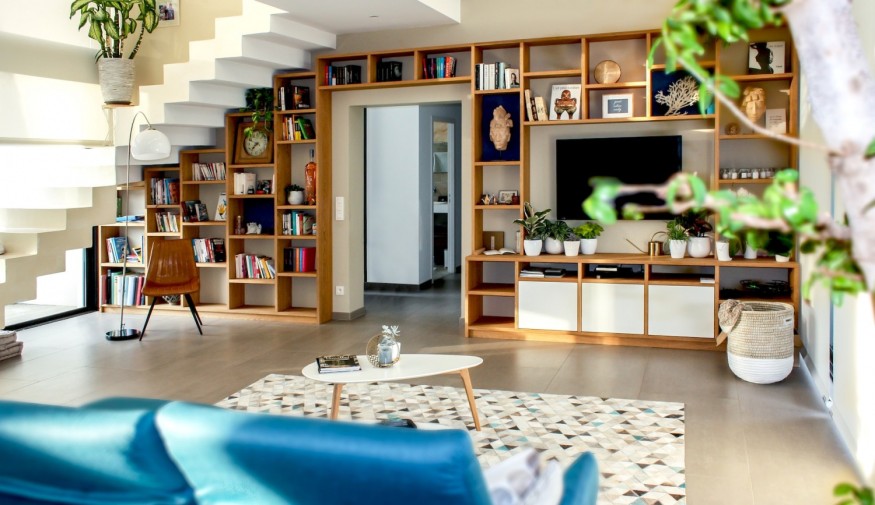
Do you ever sit in your living room, daydreaming about living in a healthier, greener space? It's not just a fantasy. A new breed of technology is turning that dream into a tangible reality, making homes more efficient and healthier places to live. But what does it mean to live in a 'sustainable home'? And how can technology help achieve this? A sustainable home prioritizes the health of its inhabitants and the planet alike. It minimizes its environmental impact while providing a healthy and comfortable living environment. A sustainable home conserves natural resources, reduces waste, and leaves a minimal carbon footprint.
Welcome to the future, where homes are self-sufficient entities. In these homes, health meets sustainability, and technology is the matchmaker. Imagine a home that senses your needs, purifies your air, reduces waste, and does it all with a minimal environmental footprint. This isn't the stuff of science fiction; it's what we call a blueprint for sustainable home living.
The Tech-Health Intersection
When you think about health, you probably picture doctor's offices, gyms, and fresh produce. But your home is a crucial yet often overlooked factor in your well-being. Research has increasingly pointed to the importance of our surroundings on our physical and mental health. Innovative tech is helping to bring that health focus into our homes. We're not talking about just air purifiers or smart thermostats. Think kinetic tiles that harness energy as you walk, rainwater harvesting systems that reduce your water footprint, and sunlight-mimicking LEDs that help regulate your sleep-wake cycle.
A New Generation of Air Purifiers
Clean air is a fundamental part of a healthy home. But how do we ensure this in an age of pollution? Enter the next generation of air purifiers. These aren't your standard purifiers that merely trap pollutants. Instead, these devices employ advanced techniques to neutralize harmful substances and even provide data on air quality.
Firstly, consider purifiers utilizing photocatalytic oxidation (PCO), a process that destroys pollutants on a molecular level. Light energy triggers a chemical reaction that breaks down pollutants into harmless substances like water and carbon dioxide. Then, there are air purifiers that go beyond purification. They monitor air quality in real-time, using machine learning to understand your home's patterns. They can alert you if pollutant levels rise too high, making you proactive rather than reactive about air quality. Such innovative air purifiers make the invisible visible and give us the information to create healthier homes. Plus, many of these devices prioritize energy efficiency, ensuring that cleaner air doesn't come at the expense of a larger carbon footprint.
The Waste Not, Want Not Home
Sustainable homes aim for zero waste in a world where our waste often outlives us. Tech innovations are making it possible to minimize and even repurpose waste right in our homes. Take composting tech, for instance. Modern, sleek composting devices fit right into your kitchen, transforming food waste into nutrient-rich soil in hours. This tech is silent, odor-free, and incredibly easy to use. Plus, you can use the resulting compost in your home garden, effectively closing the waste loop. Then there's greywater recycling technology. These systems recycle water from showers, sinks, and washing machines, treating and reusing it for toilets and garden irrigation. Not only does this tech reduce water waste, but it also lowers water bills.
The Self-Powered Home
The home of the future doesn't merely consume energy; it produces it. Homes are becoming power stations, from solar panels to wind turbines. But sustainable energy generation isn't limited to rooftops anymore. Window panes are doubling as solar panels, capturing energy while letting light through. Kinetic energy systems turn daily activities like walking or showering into power sources. Even Wi-Fi signals are being harnessed to generate electricity, with tech known as 'rectennas.' Moreover, smart home battery systems are maximizing the use of this self-generated energy, ensuring no power goes to waste. They store excess energy produced during the day to use when demand is higher, keeping your home powered while reducing reliance on the grid.
Your Home, Your Health Coach
The final piece of our sustainable home blueprint involves tech that helps you make healthier choices daily. Imagine a mirror that analyzes your skin health, giving you personalized skincare advice. Or a smart yoga mat that offers real-time corrections to your posture. What about a showerhead that tracks water usage and encourages conservation? Such tech nudges us to make health and sustainability a part of our daily routines. It allows us to take charge of our well-being while contributing to a healthier planet, making our homes not just places to live but partners in our journey towards a more sustainable lifestyle.
The Future Is Now
A healthy, sustainable home may sound futuristic, but it's happening now. Technology is reshaping our living spaces, intertwining health and sustainability in ways we could have only dreamed of a few years ago. Of course, every home won't include all these features overnight. But even small changes can make a significant difference. Maybe it starts with an air purifier that monitors air quality or a simple composting device. Whatever your starting point, these innovations mark a new era of home living. A sustainable home isn't just a blueprint for a healthier you. It's a blueprint for a healthier planet. As we face a climate crisis, these homes represent a beacon of hope, showing that we can live in harmony with nature without sacrificing comfort or health. This, then, is the blueprint for sustainable home living.
© 2025 NatureWorldNews.com All rights reserved. Do not reproduce without permission.





